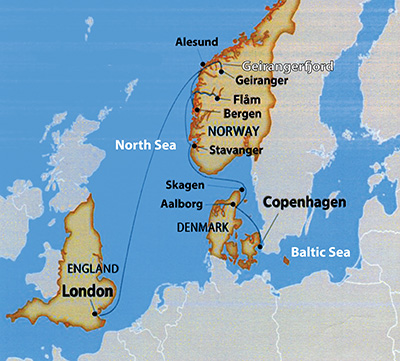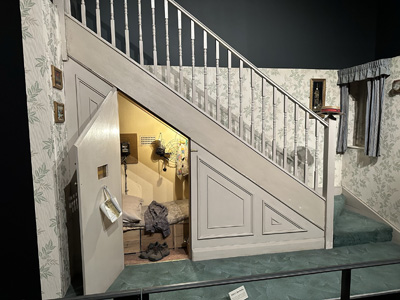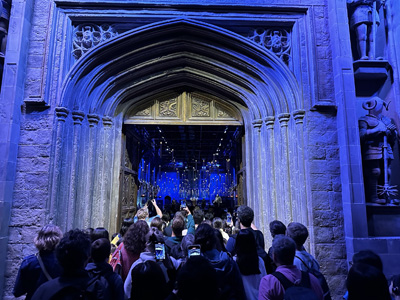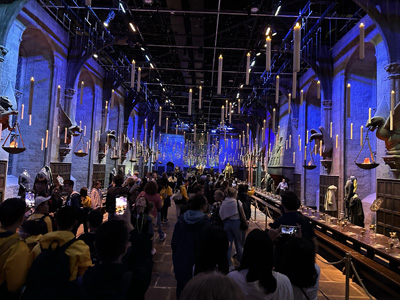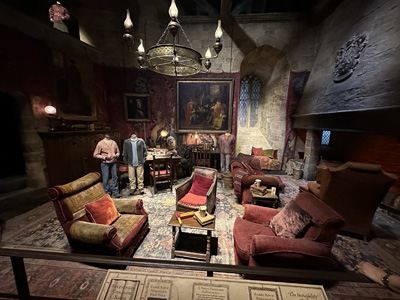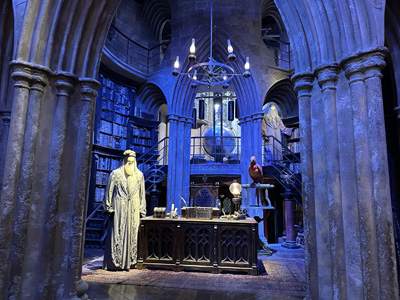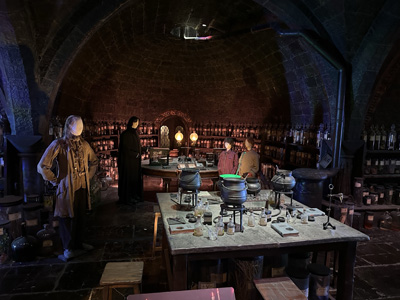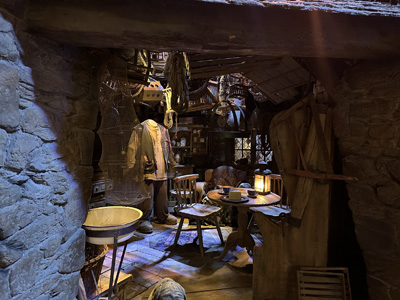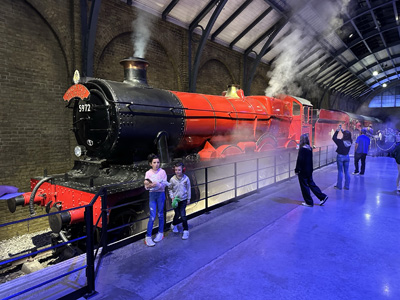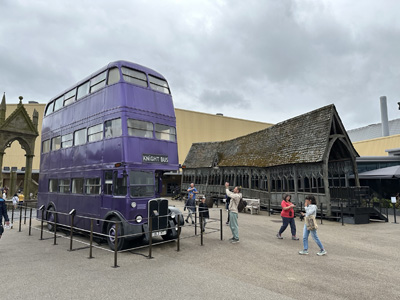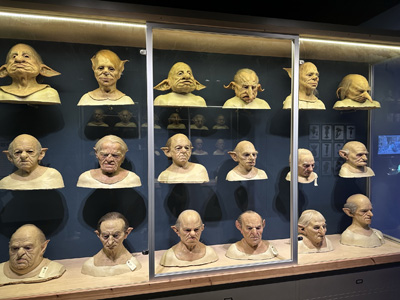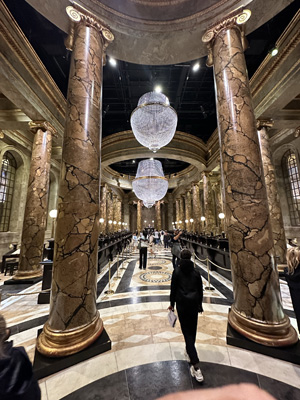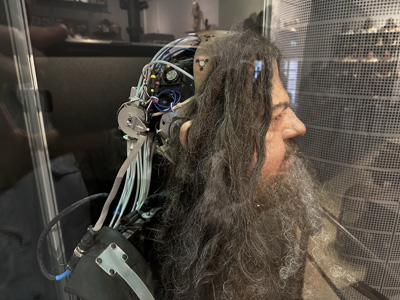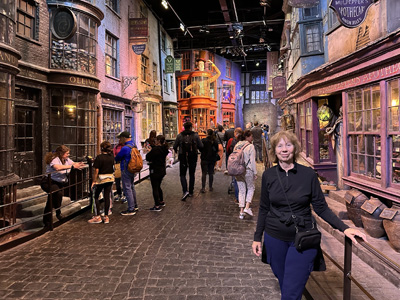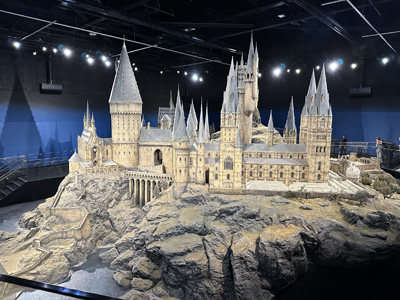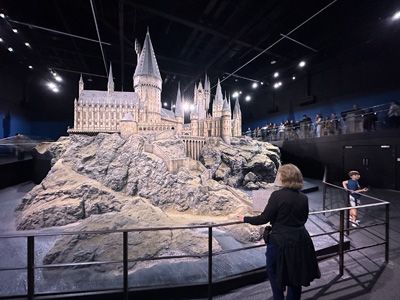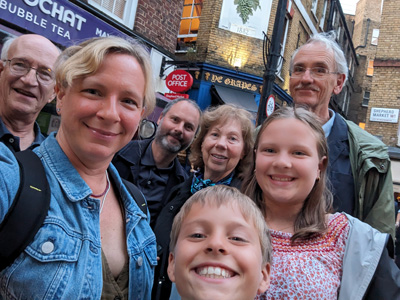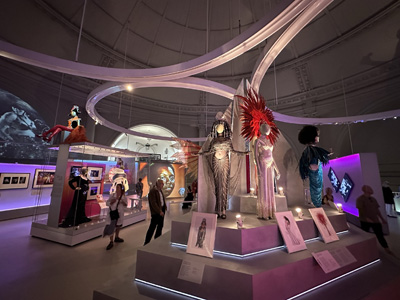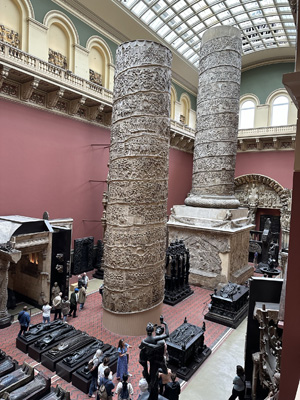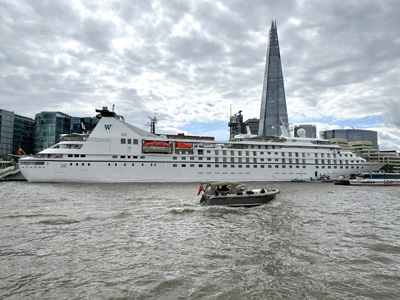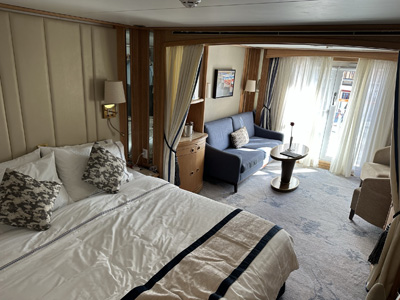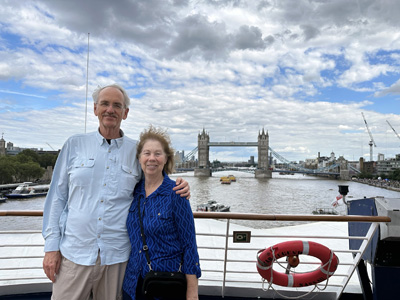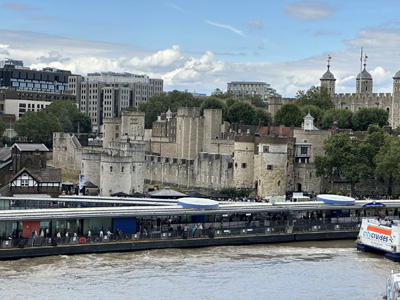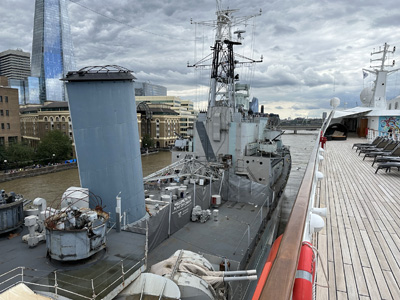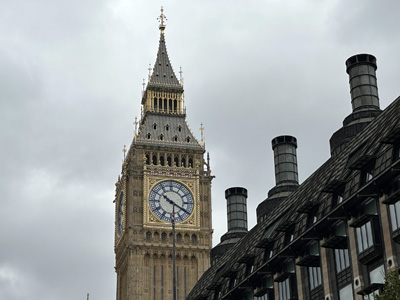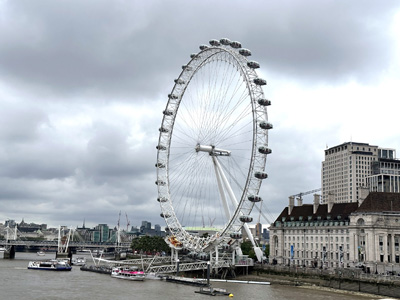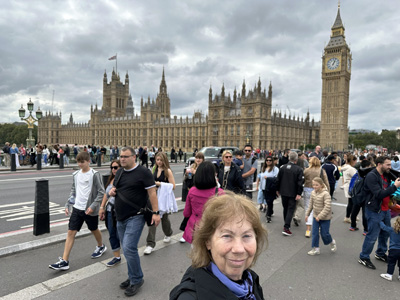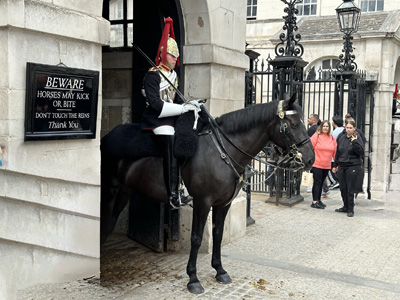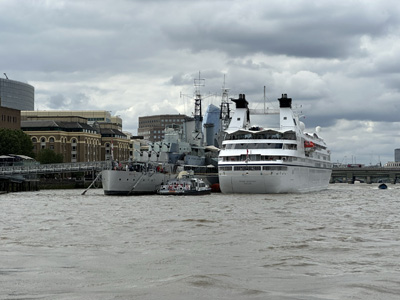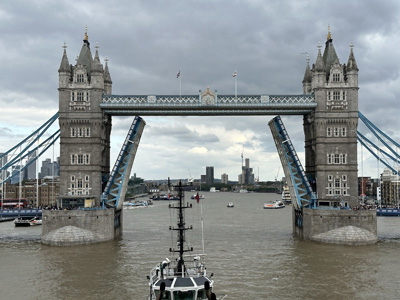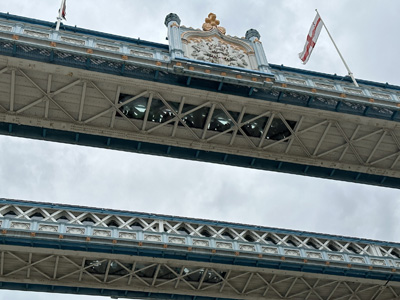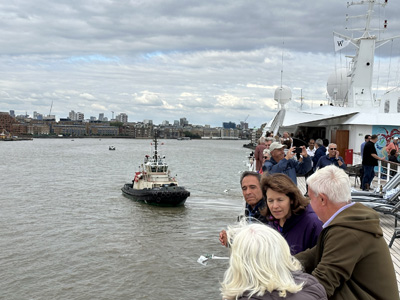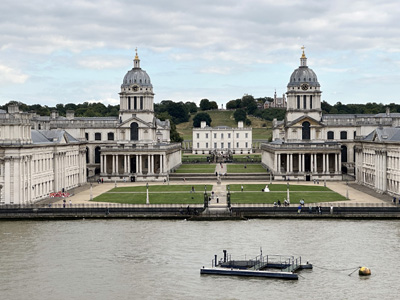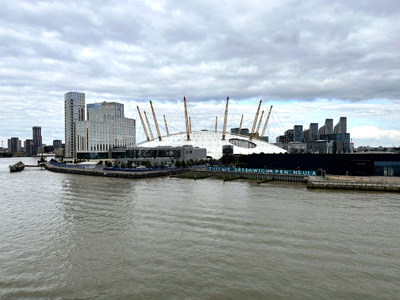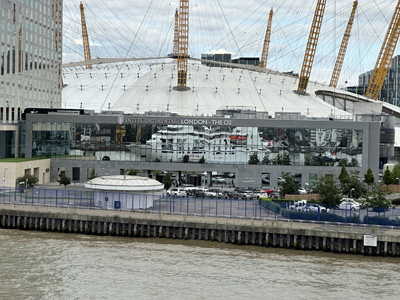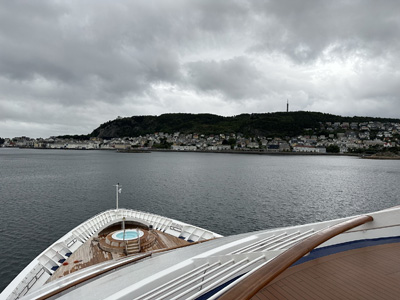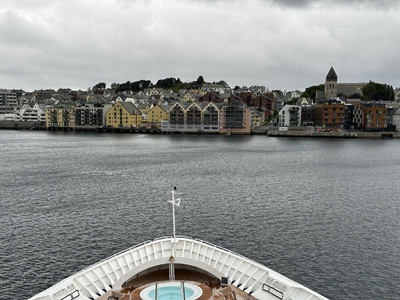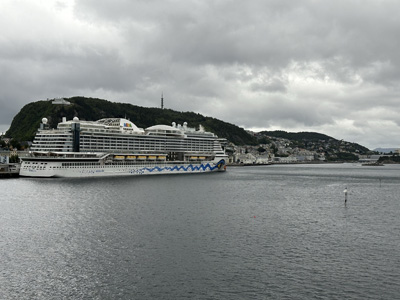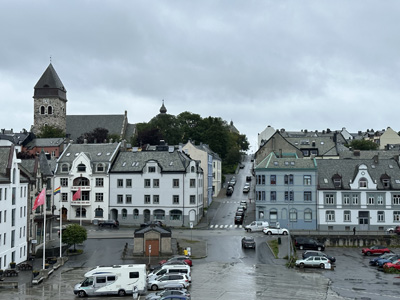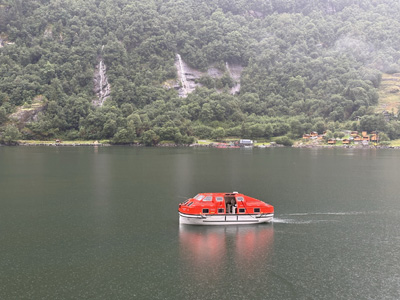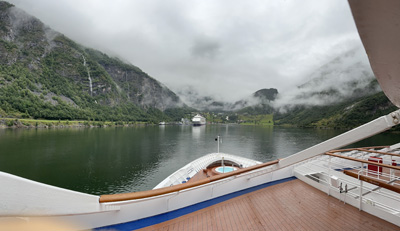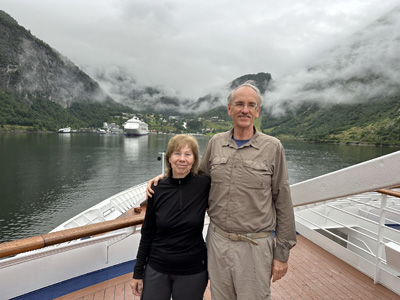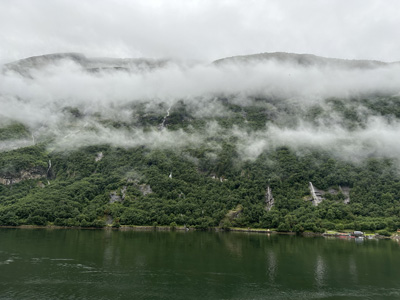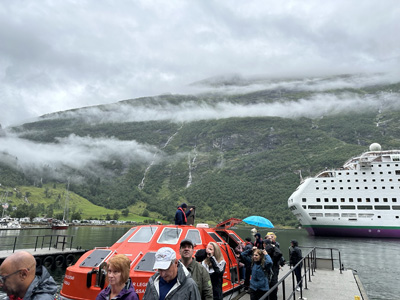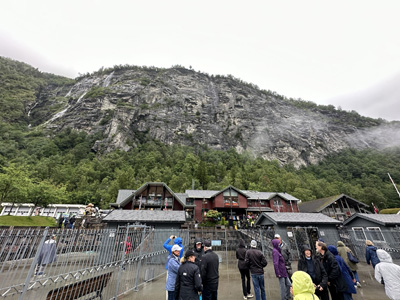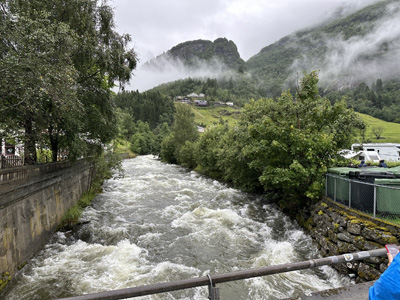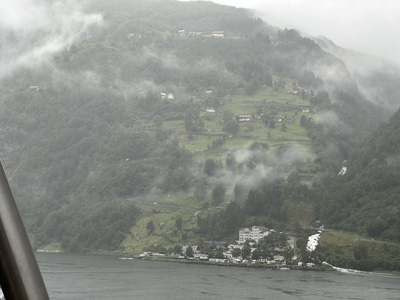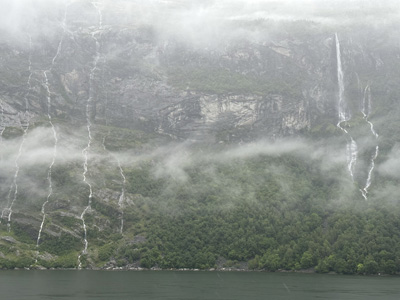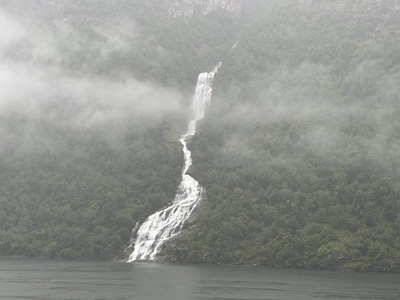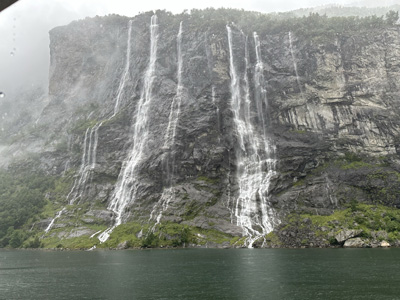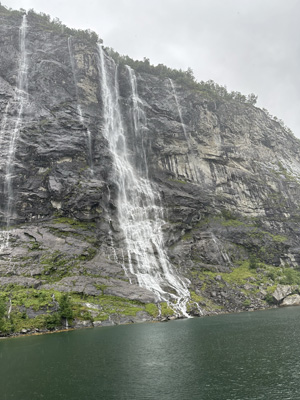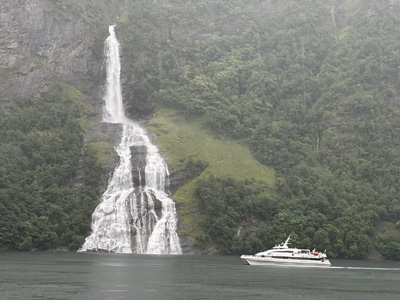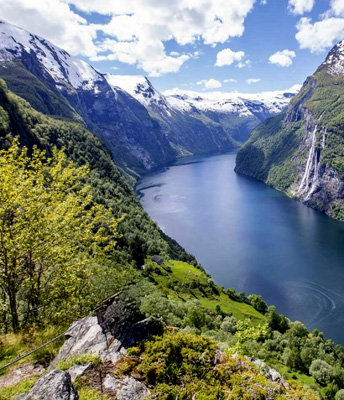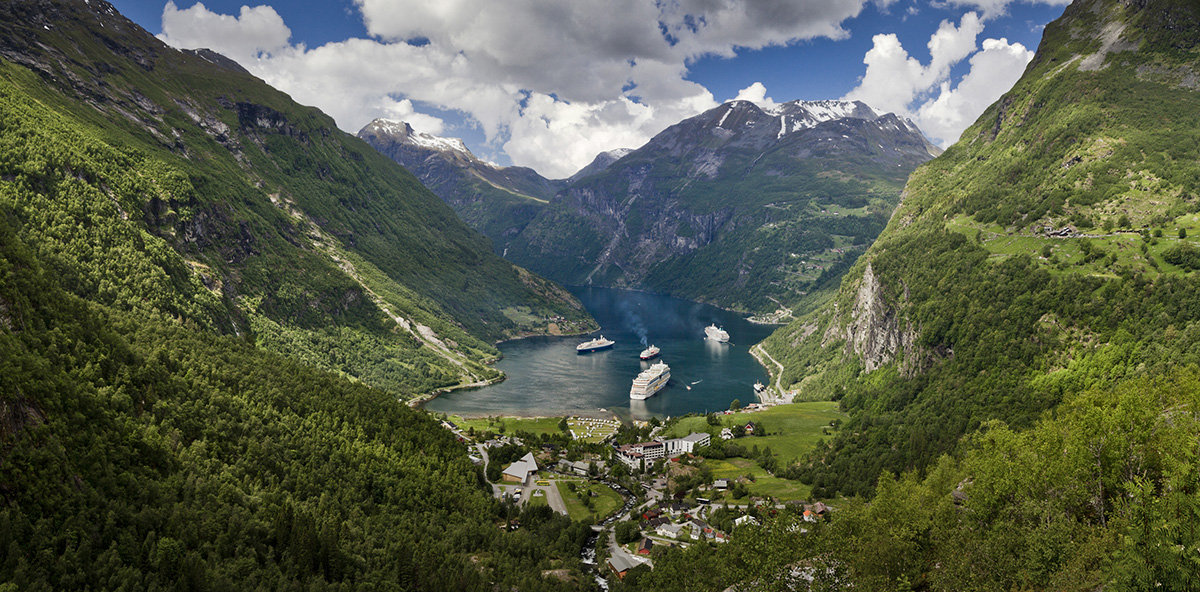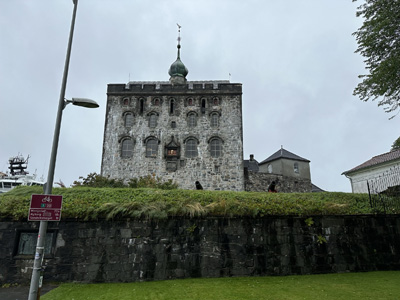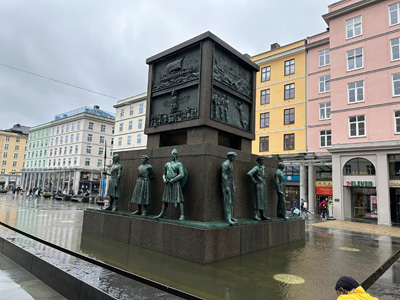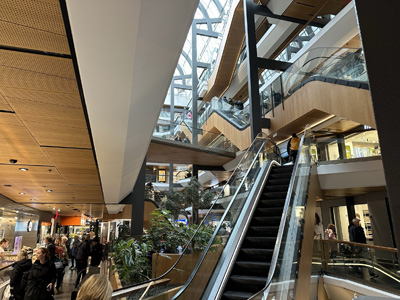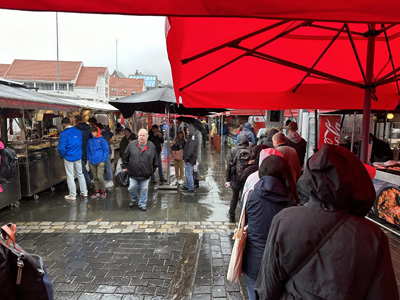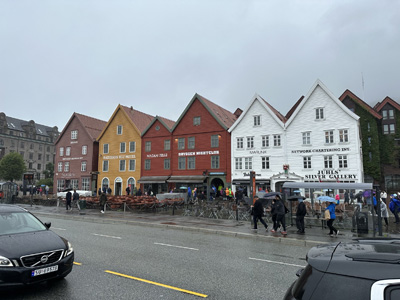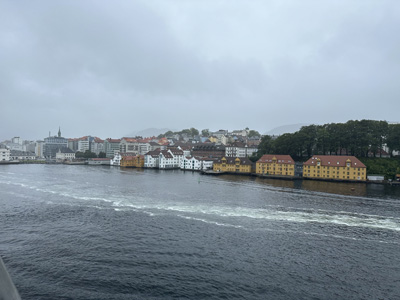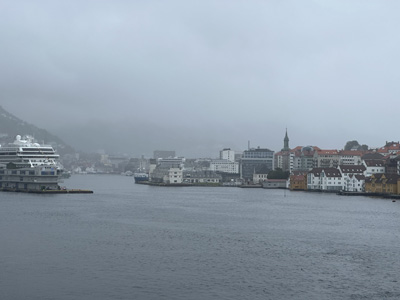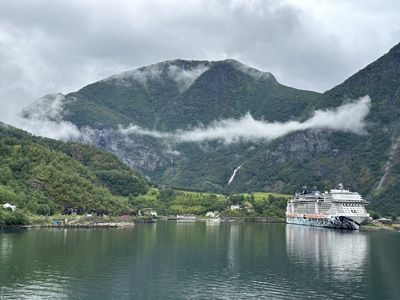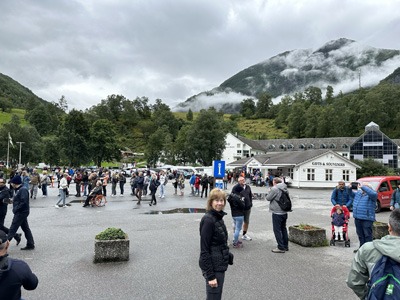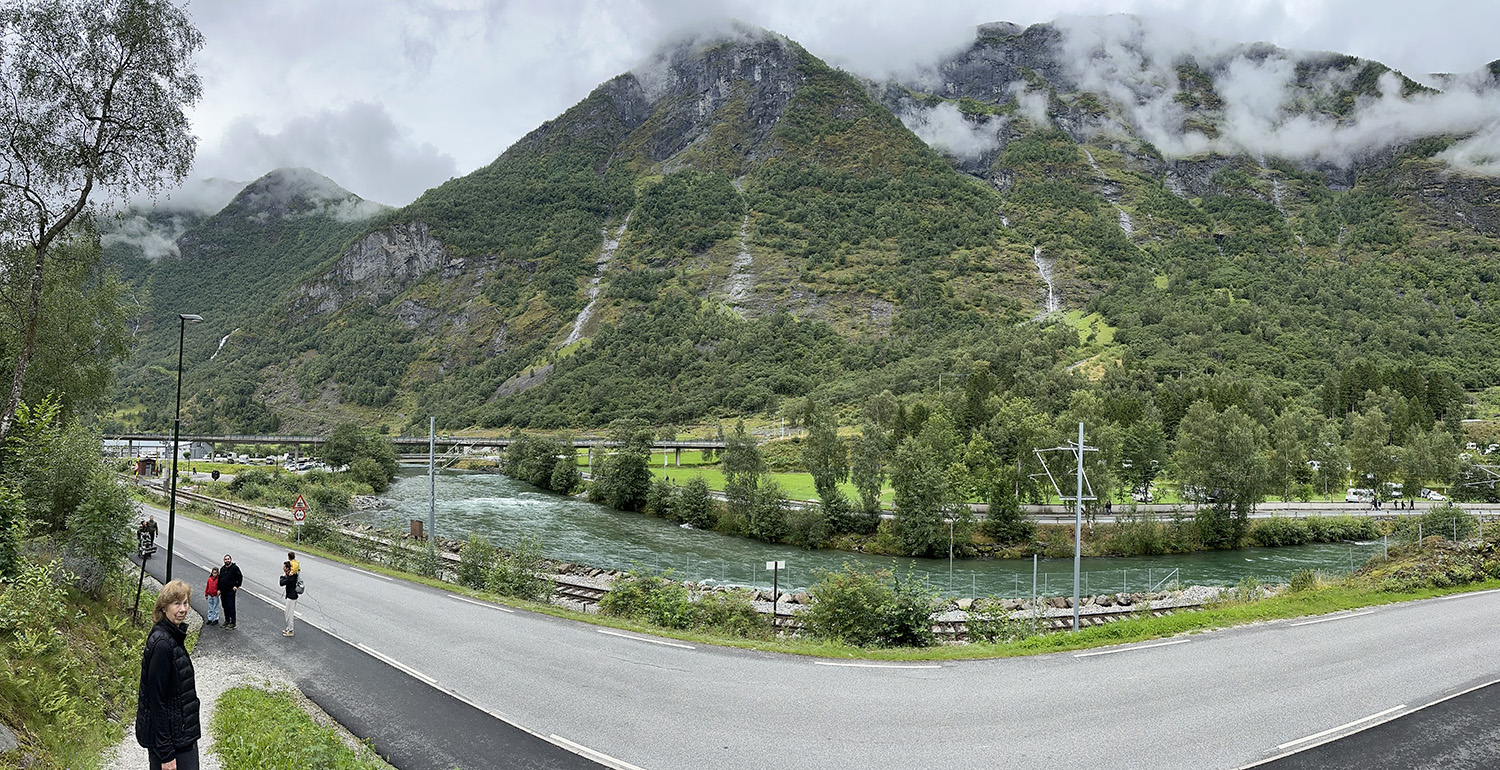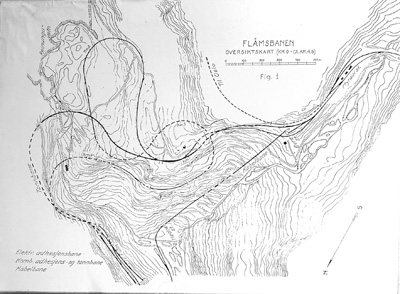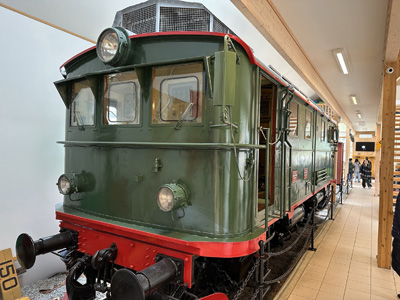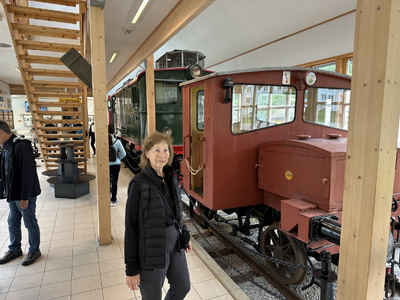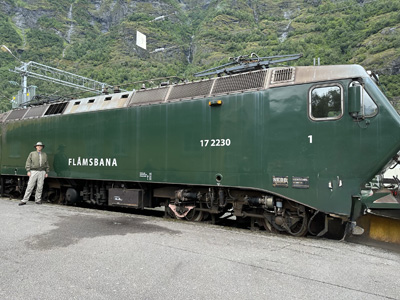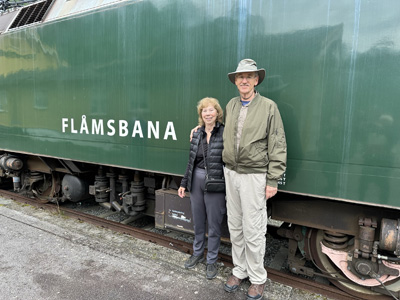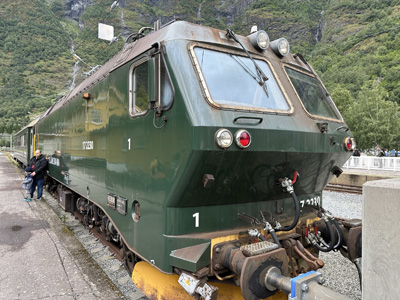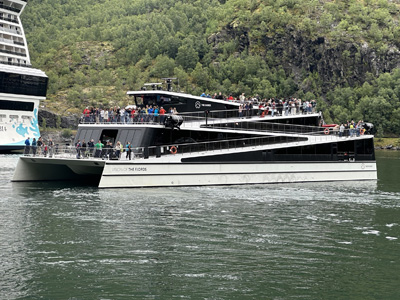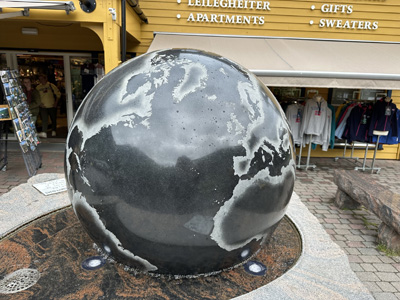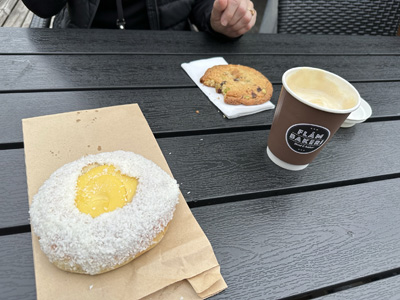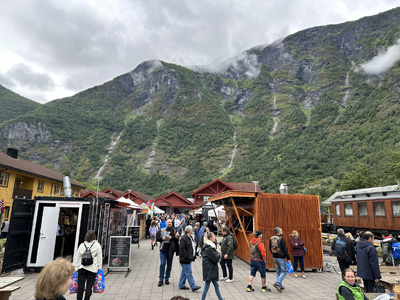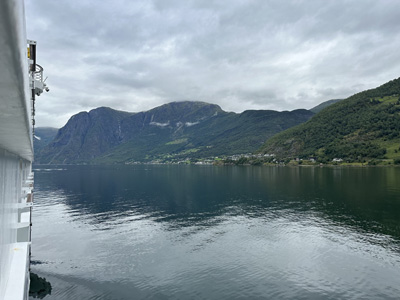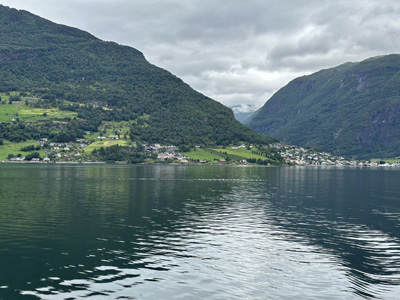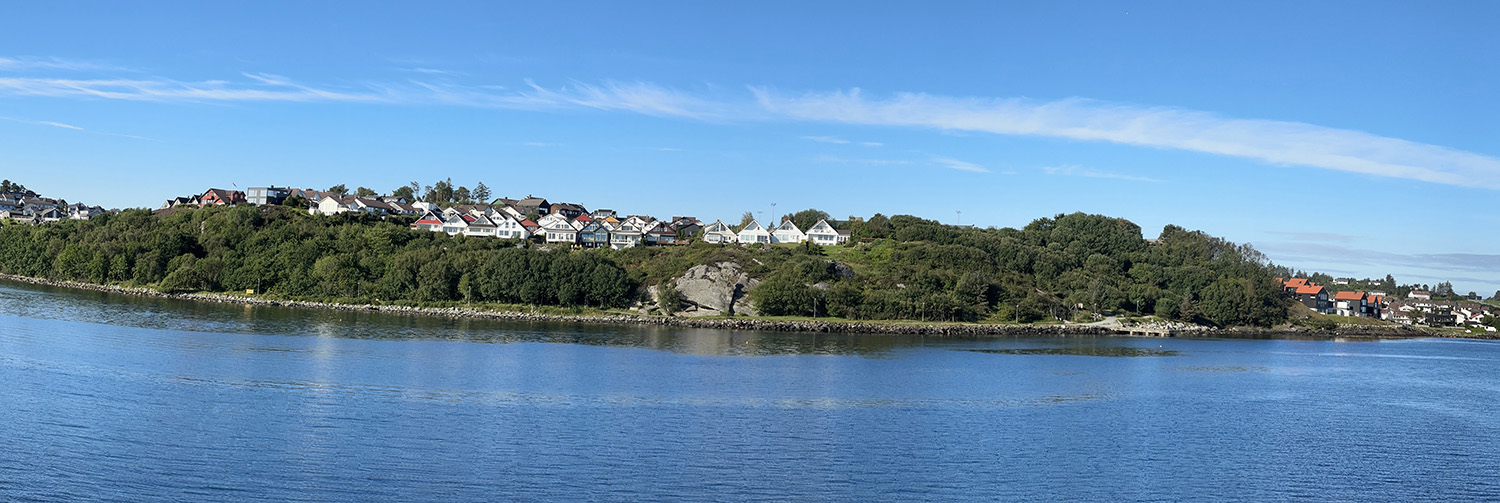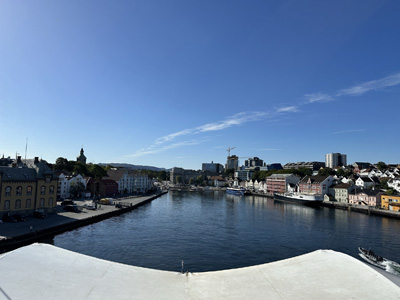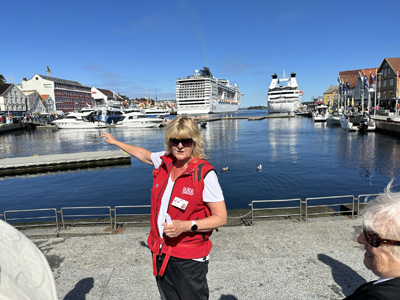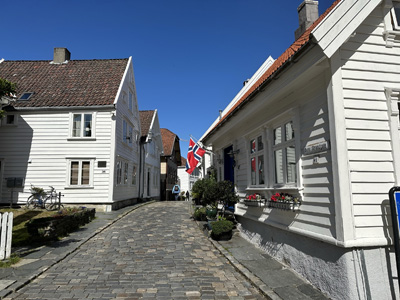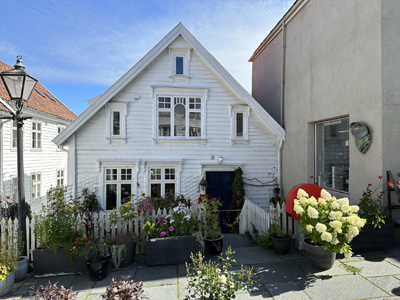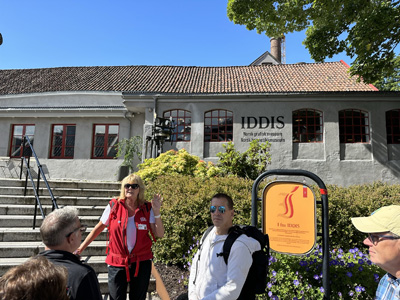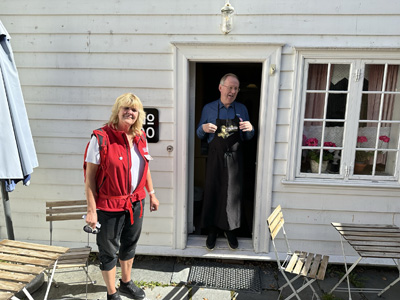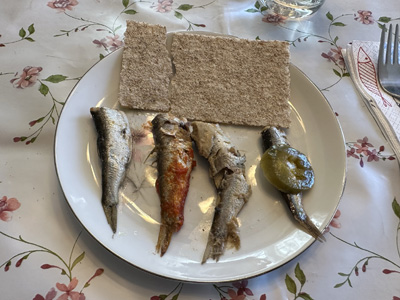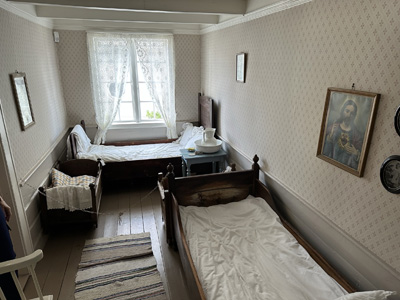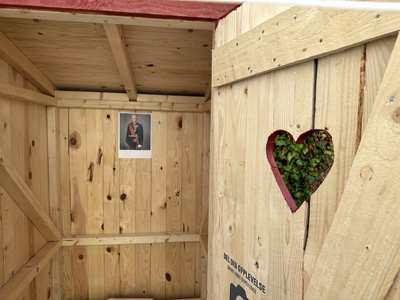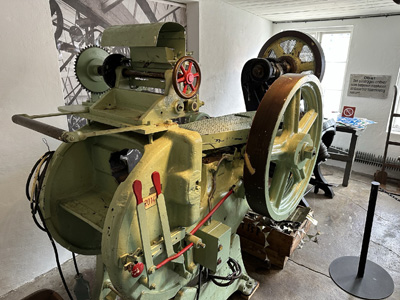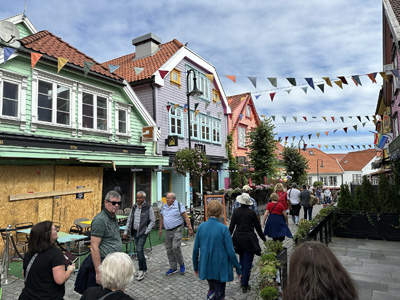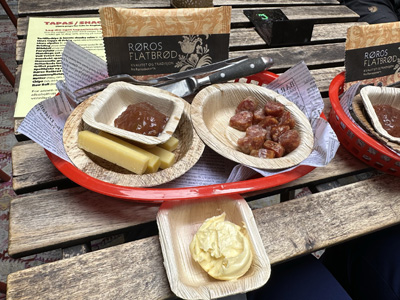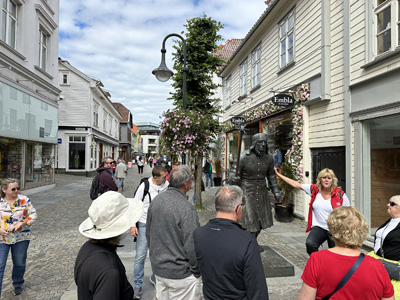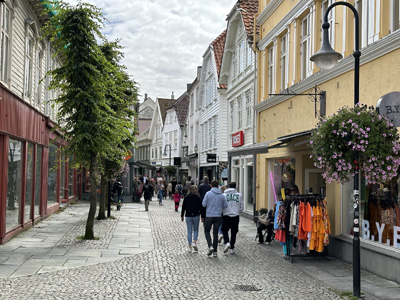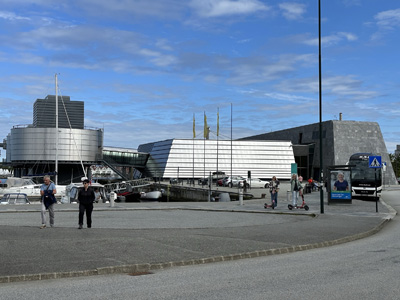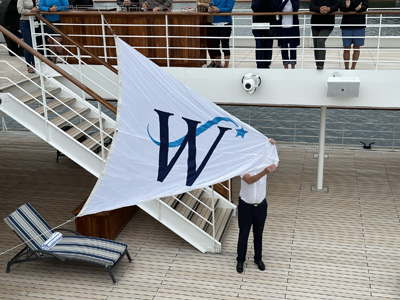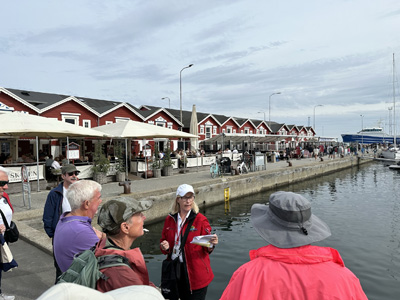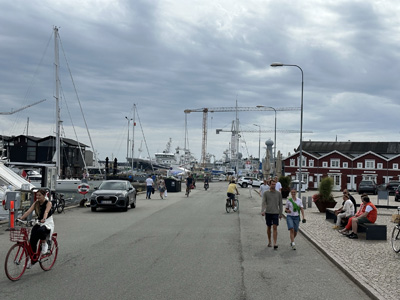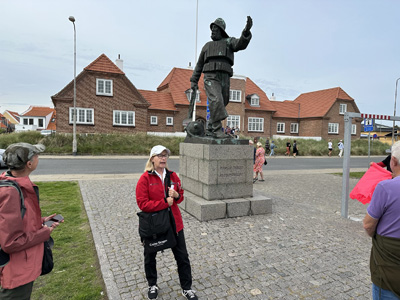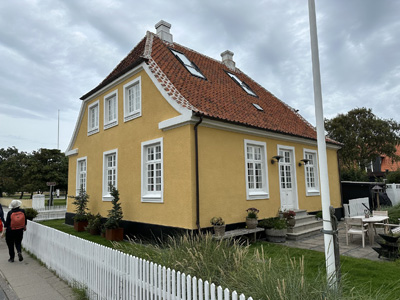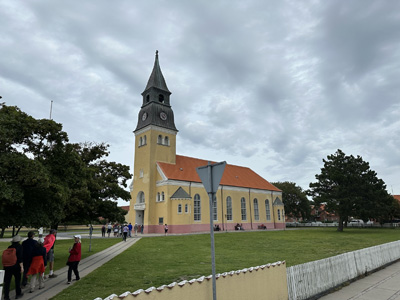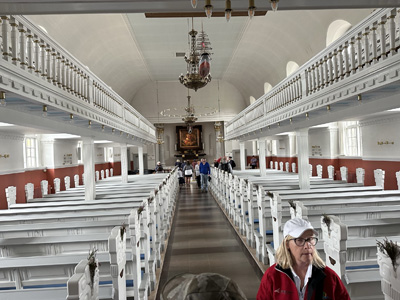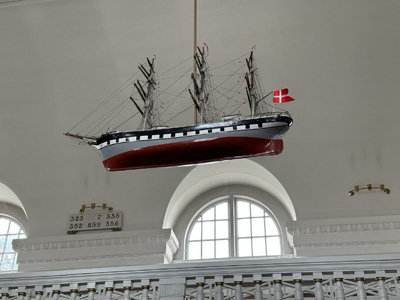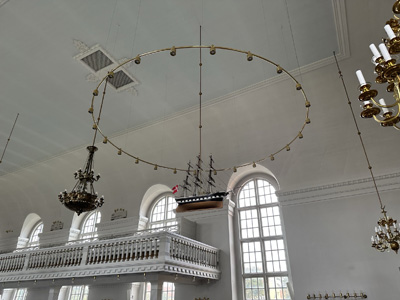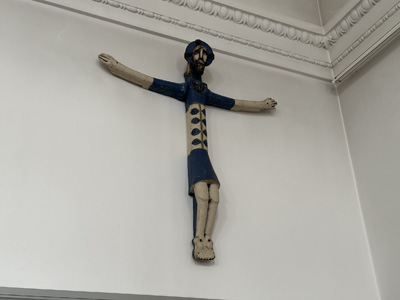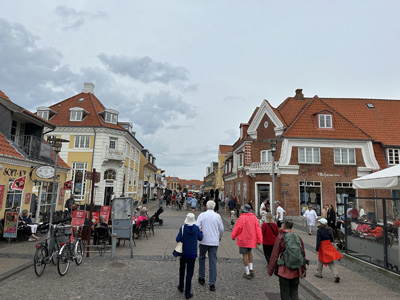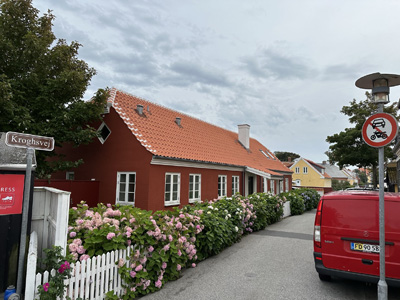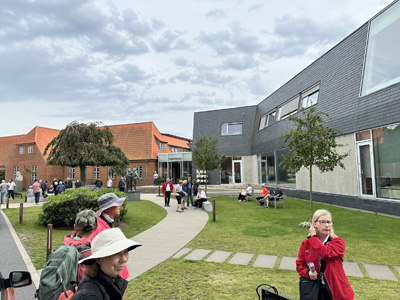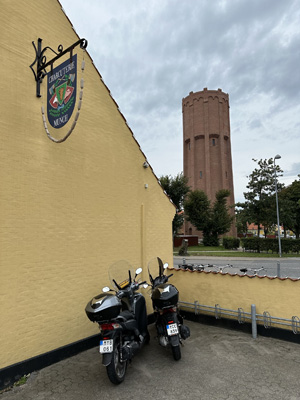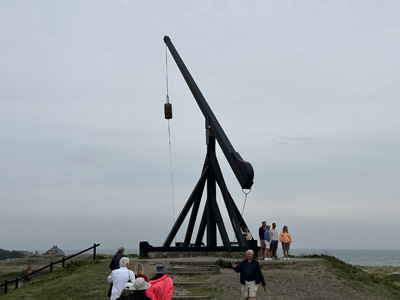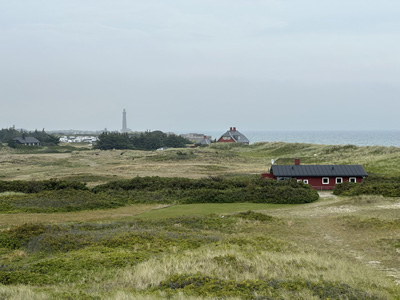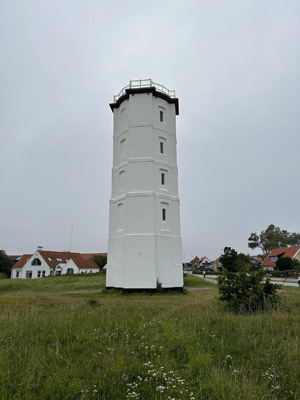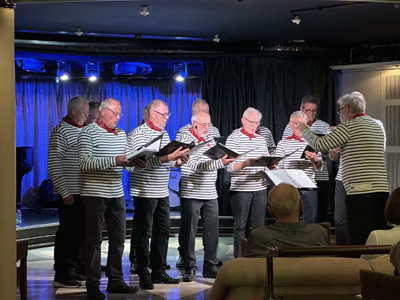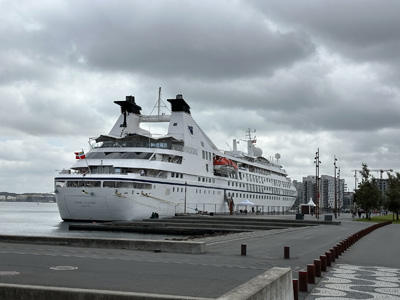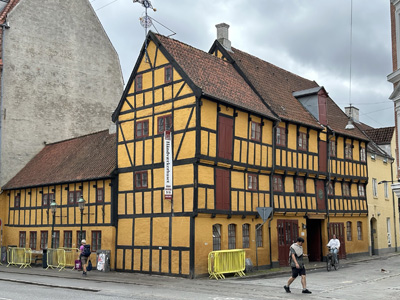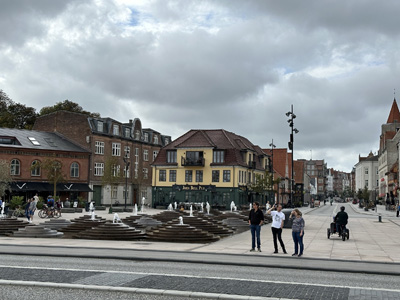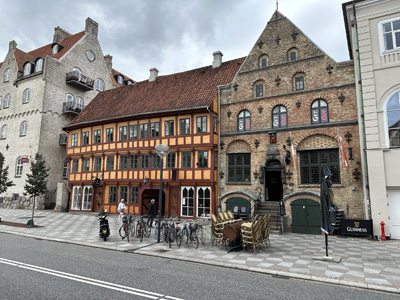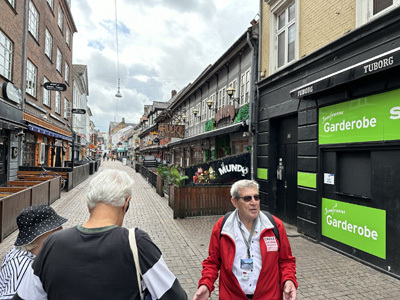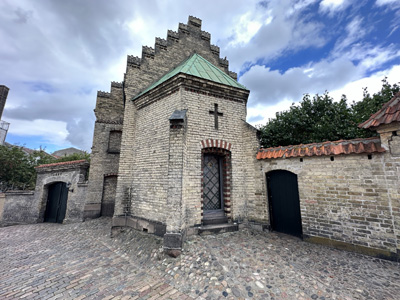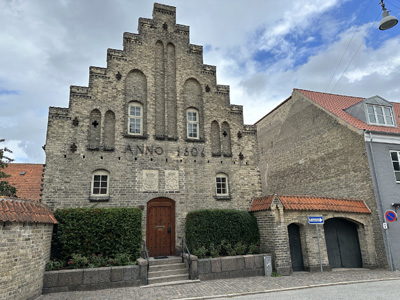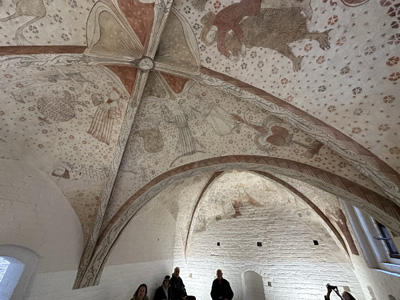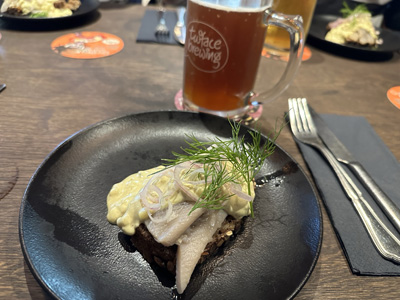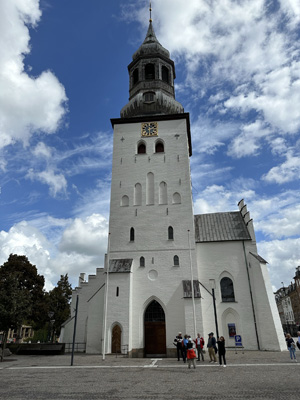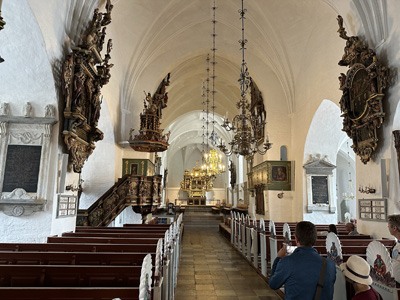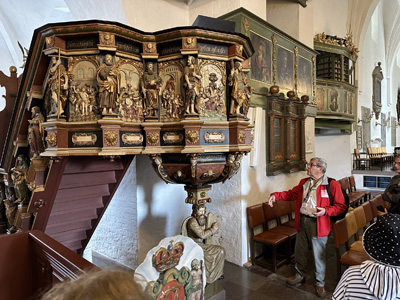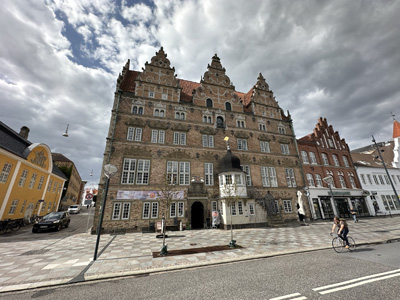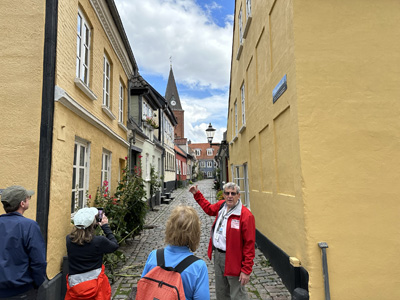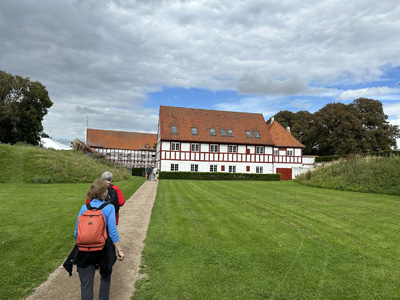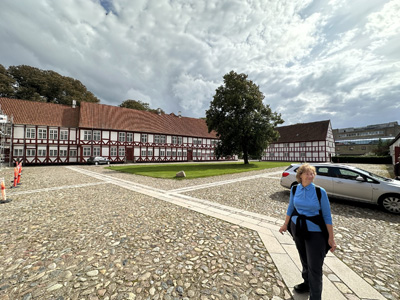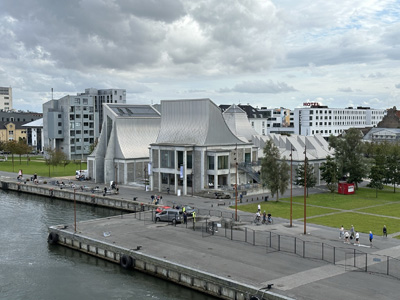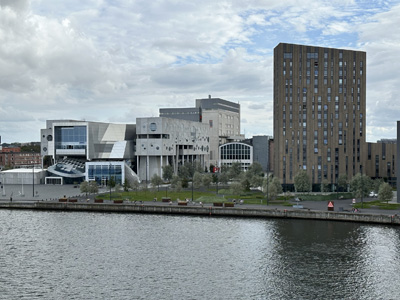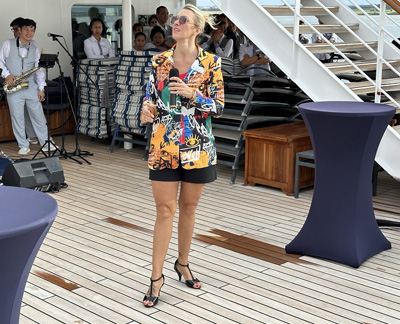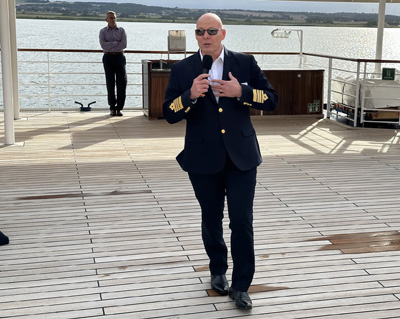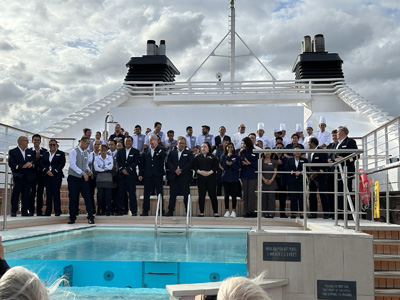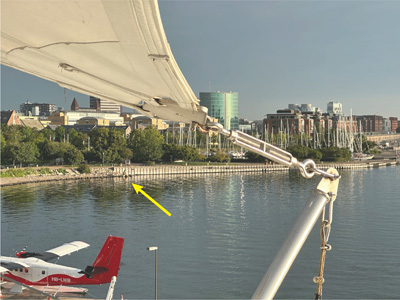Hal and Nancy’s 2023 Norwegian Fjords Cruise, August 2023
This is my (Hal’s) report of Hal and Nancy’s cruise from London to the Norwegian fjords and Denmark on Windstar’s Star Legend. We had cruised with Windstar a few times—see 2001, for example—but that was over 20 years ago, and exclusively on their sailing ships, Wind Star and Wind Song.
Monday, July 31 — to London
We flew United Airlines nonstop overnight to London Heathrow. The Polaris lounge at SFO is quite nice and we had a very good light dinner in their dining room, which made it easy for us to forsake dinner on the plane. As usual, I used my TimeShifter app and it directed us to the appropriate timing for lighting, caffeine, and sleeping to escape the ill effects of jet lag almost entirely.
Tuesday, August 1 — London
We arrived on time at 2 PM and raced effortlessly through immigration and customs. We took the Piccadilly tube line for 50 minutes to the South Kensington station and then walked a few blocks to our hotel, the Franklin London. It’s a boutique hotel that had somewhat small rooms, but it was very comfortable and super quiet, a real treat. Excellent staff, too. We needed some exercise, so walked about a mile and a half to Kensington Palace, which turned out to be closed on Tuesday. We wanted to experience a pub dinner, so tried the nearby Hoop and Toy, which was pretty disappointing—poor beer selection and a menu that had a number of depleted entries. It is one of a chain owned by Greene King, which apparently has a poor reputation.
Wednesday, August 2 — London and Harry Potter
We walked a mile to Victoria Coach Station for a bus to the Warner Brothers Studio Harry Potter tour in Watford, about 70 minutes north. This was rather expensive, but quite enjoyable. It’s a self guided tour through two large buildings that are filled with actual sets, costumes, and artifacts from the eight movies. There are video interviews and a few live demonstrations along the way. I was most interested in the special effects, including quite a bit of animatronics (the early movies are 20+ years old, after all, when CGI was not as prominent), and Nancy in all the graphic design and imagination. We learned that the actor playing Hagrid, when Robbie Coltrane wasn’t doing him in closeup, was 6’ 10”, but that wasn’t tall enough for a half-giant, so they topped him off with an animatronic head above his own. Very realistic looking. Some impressive sets were the main dining hall and Gringotts Bank. There is an outside area with the Dursley House, the Knight Bus, and a scale model of the Weasley Burrow. The most awesome part of the tour was at the end, when you visit an enormous, super-detailed scale model of Hogwarts, over 50 feet in diameter.
Dinner was with some of my London-based cousins at the Mayfair branch of the Noble Rot restaurant group. This was an excellent meal with a very expansive wine list.
Thursday, August 3 — London Embarkation
We started at the Victoria and Albert Museum, almost across the street from our hotel. The museum is free, but we paid for a special exhibition called Diva. This was quite enjoyable, a look at (mostly) female opera singers, pop stars, and movie stars, from the late 19th century until today. They included some film clips, posters, and elaborate costumes. The coolest aspect was the audio headsets, which were set up with ultrawideband sensors, like the Apple U1 chip, that knew exactly where you were standing and automatically changed the audio appropriately. Afterward we roamed through a number of design exhibits, including the largest collection of cast iron I have ever seen assembled.
We had a so-so lunch at Pizza Express, which I had previously thought was pretty decent, and then headed for the ship. It was 4 miles from the hotel by Uber, but that required 50 minutes in London traffic. Although MV Star Legend was docked adjacent to HMS Belfast on the Thames, any passenger arriving there on the south side of the river was disappointed to hear that they had to travel to the north side, to the Tower Millennium Pier, to be tendered across. Fortunately I had done my homework on this, but we heard typical cruiser complaints that many of them had not researched it and encountered unexpected extra taxi expenses. (Some cruisers we met had actually been informed by Windstar corporate HQ that the ship would be boarded in Portsmouth, so many hundreds of pounds of erroneous taxi fares had to be reimbursed by the company.)
The Star Legend is the former Seaborne Legend—star of the great film Speed 2 Cruise Control with Sandra Bullock—cut in half and stretched 25 meters for additional cabins. It carries 312 passengers in modest suite configurations. The décor is a bit dated and the ship was undoubtedly designed by someone under six feet tall, which I know because there are dozens of places, including in our cabin, where I have to duck. Our cabin/suite is an odd one that looks like it has a balcony/veranda, but one that is only one foot deep, so you can open the two heavy doors and look out, but you can’t go outside and sit.
We originally thought we’d have dinner on shore for our last night in London, but didn’t find anything within walking distance that seemed interesting, so we tried Amphora, the ship’s main dining room. The food was quite good and they have a very reasonable list of wines by the glass.
Friday, August 4 — London Sail Away
The weather forecasts from yesterday said it would rain all day Friday, but thankfully they were completely wrong and we had merely overcast skies. We tendered over to the Tower pier and got on a hopping bus* for a 2.5-hour narrated tour of London. Nancy always enjoys these. We jumped off at Westminster to eat lunch (I finally had fish and chips) and walk around the government area and over to Trafalgar Square. All of these areas were simply jam-packed with tourists. One highlight for Nancy was seeing the Queen’s Horse Cavalry mounted sentries keeping quiet guard at their gate. Then back to the Thames, where our bus ticket gave us a one-way boat ride down river to the Tower pier.
* Nancy insists that I explain that "hopping" is my cute abbreviation for "hop-on-hop-off."
Star Legend departed after 4 PM. It was an unusual maneuver because we backed up under the Tower Bridge and went backwards for a mile or so until we reached a wider spot where we could rotate and proceed forward. Nancy and I watched on deck for about 90 minutes and we finally went inside after we crossed the Prime Meridian at Greenwich and entered the Eastern Hemisphere. (I was disappointed as a cartographer that the captain didn’t announce this over the PA. I also lamented that they don’t play the dramatic Vangelis 1492 song while departing, as Windstar always did on their sailing ships.)
Dinner in Amphora again. Excellent beef Wellington.
Saturday, August 5 — At Sea
Heading north into the North Sea under rainy skies, we attended a briefing on upcoming shore excursions, all of which seemed interesting—assuming the weather cooperates—but are glaringly expensive, usually $50–150 per person per hour. We’ll be watching the weather and booking things ourselves.
Then, a cooking demo with the ship’s executive chef, Joseph, on Norwegian cuisine. He made Icelandic meatball stew with egg-lemon sauce and a form of dolmas wrapped with eggplant instead of grape leaves. Oddly, neither of these dishes is offered in the dining room and some US public health regulations prevented the audience from sampling the dishes, but both looked delicious.
In the afternoon we had an initial talk from an outside lecturer, a geography professor named Doughty, on fjords around the world, although he managed to include quite a number of bird photos. At 6 there was a reception in which the captain introduced the ship’s officers. Then dinner in Amphora with an excellent venison loin.
Sunday, August 6 — At Sea
We continued through the North Sea, today under sunny skies, giving clear views of the occasional oil platform. Last night the ship skipped ahead an hour to Central European Summer Time. A pretty lazy day: a lecture about Viking migration west of Scandinavia and a brief update on Ålesund port information. Dinner at Amphora featured an excellent spaghetti carbonara. Quite a bumpy night at sea.
Monday, August 7 — Ålesund, Norway
We arrived in drizzly overcast and a forecast for heavy rain later this morning. It's 62°48’ north latitude here, the furthest north I have ever been in Europe. A big German cruise ship, Aida, was already docked. The town is set on a few islands and is pretty with colorful buildings in the Jugenstil style, which is sort of like a German art nouveau. All the buildings were destroyed in a great fire in 1904 and were rebuilt in that common style. (Kaiser Wilhelm was a fan of this area and helped finance the reconstruction, which I’m sure the locals forgot about during their experiences with Germany in WWII.) By the time we left the ship it was 50°F, windy, and rainy, so quite miserable. Weather conditions dissuaded me from taking my camera out very often.
We took a hopping bus for a 70-minute narrated circuit of the town, including a small mountain called Aksla, which would have had a beautiful view of the harbor, except that it was fogged in. (We later talked to a couple who had hiked up that hill, ignoring the rain.) And the bus windows frequently fogged up, too. Our plan after the bus was to find the local history museum, but it was a number of rainy blocks away and wasn’t open yet, so we bailed out and returned to the ship for the rest of the day.
There was an afternoon game of Scattergories, hosted by entertainment director “Zoltina-J,” a hot young Aussie woman, and we got skunked by the other teams. Tonight is our 47th wedding anniversary, so we ate in one of the two specialty restaurants, the Candles steakhouse, which is the Veranda lunch restaurant reskinned with white tablecloths and an upscaled menu. On tropical itineraries, this is a romantic candle-lit outdoor restaurant. I had an excellent NY steak. Afterward we adjourned to the Compass Rose bar (well named for a cartographer like me) for an hour of nice guitar—and some banjo—music by a local performer, Stig Ulv.
Tuesday, August 8 — Gieranger, Norway
Overnight we sailed up the nearby Geirangerfjord and anchored outside the tiny village of the same name. Right outside our cabin window is a spectacular steep cliff with numerous thin waterfalls. It’s rainy again and the Norwegian weather service posted a warning that this is the most severe rain in 25 years, causing mudslides and road closures. They called it “extreme weather Hans.” In fact, all of the shore excursions have been canceled, other than a “rib boat” adventure that is entirely on the water. By mid morning there was a brief break in the rain, so we tendered to the town and walked around for about an hour. It’s quite small, but has a hotel and numerous cafes and souvenir shops. We started on the waterfall walk and were impressed with the high volume and fierceness of the flow. If we had walked dozens of flights of stairs, we could have reached the Fjord Center that has some exhibits, but we demurred. The only other landmark is an octagonal wooden church from the 1850s, but that was quite a ways up the rather steep hill.
Our ship departed at 1:30 for scenic cruising on the fjord, which would have been spectacular in warm, clear weather, but the views were obscured by drifting low fog. We stopped by the famous Seven Sisters waterfalls and then turned around to see their companion waterfall, the Suitors. The photos below of these falls were from our cabin mini balcony. We spent the rest of the afternoon traversing the narrow fjord back to the North Sea, passing lots of waterfalls along the way.
Our lecture today was on the problems of the Norwegian salmon industry, which is overwhelmingly farmed, and has a variety of issues with its giant cages in hundreds of fjords. We learned more than we ever wanted to know about sea lice. Interestingly, Nancy and I very rarely get Atlantic salmon, which is a different species than our more familiar Pacific salmon. Dinner in Amphora again, a tasty red snapper. The sea has become really rough and waves are crashing up against the portholes of the Deck 3 dining room. It is amazing that the waiters can do their jobs under these conditions. All the passengers looked like vaudeville drunks lurching down the hall and we had very strong rocking and cabin-creaking all night as our rather small ship headed south in the open waters.
Wednesday, August 9 — Bergen, Norway
Bergen is surrounded by lots of islands, so the water calmed down as soon as we were sheltered from the North Sea. But it’s still raining. We walked downtown, maybe a half mile to the visitor center, and chose a hopping bus for an overview of the small city (260,000 folks, but second biggest in Norway). It’s split in about half by the large port and there were numerous large commercial vessels in today, including two large cruise ships, dwarfing ours. One area is full of attractive old wooden buildings, in bright colors, called Bryggen, or the German Wharf. There are seven large hills and one has a cable car running up, but we didn’t bother because the view would have been zero. We walked next to a busy fish market and through an area with different local cuisines served from tents. I had a reindeer hotdog, which tasted pretty much like a regular large sausage on a bun, with mustard, elderberry sauce, and dried onions. Delish. We also walked through a very attractive shopping mall, the Galleriet, and had pastries and lattes. All in all a nice city, but since they told us on the bus that there are 230 days of rain a year, not one we’d want to live in.
No lecture or interesting games today, but we did nap, probably inspired by the glass of hot mulled wine I had in the afternoon at sail-away. They finally rolled out the Vangelis song, which is audible only outside. Another dinner in Amphora, an excellent planked salmon. After we left the protected island waterways, we got back to heavy waves in the North Sea, which kept us rocking until 11 PM.
Thursday, August 10 — Flåm, Norway
For some reason our itinerary was south to Bergen yesterday, but then back north to Flåm today. We traveled the beautiful Sognefjord—the “King of Fjords,” the longest and deepest in Norway—while we slept and woke up (late!) anchored outside the tiny town of Flåm. To our surprise, three weather apps from last night were dead wrong and we did not have continuous rain all day. In fact, it was high overcast and decent walking around weather. If we could have predicted that, we would have booked a ride on the Flåmsbana railroad, but all the trains were full today. It’s a cool ride that ascends dramatically through loops and tunnels. Folks we talked to afterward said it was great, the best thing on the trip so far.
A big MSC cruise ship shared the port with us, so five thousand European tourists were here, making the place sound like a United Nations convention. Nancy and I took a brief hike in the Fretheim Cultural Park and visited the train museum. We found the town’s bakery and I had the same delicious pastry with custard and coconut that I found in Bergen, which I believe is called a skolebrød, or “school bread.” There was a street with lots of food trucks and I could have had another reindeer hotdog (but mixed in with “mountain cattle beef”) but wasn’t very hungry after the large pastry.
Sail-away was at 3 and they played the 1492 song and ran up a white Windstar flag (in lieu of sails) to great applause. Then, if on cue, light rain started and chased us all inside. There are 95 nautical miles to go inside Sognefjord before we reach the sea and head south. Quite scenic, with tiny towns and farms perched on the sides of super-high green cliffs. We skipped the fourth lecture about invasive species in Norway. There was a Mideast Bazaar in the lounge, which included some typical ethnic drinks and light dishes, all in service of marketing Windstar’s Middle East itineraries late this year—by this very ship. Dinner at Amphora included an okay duck confit. We reached the North Sea about 9:30; the seas aren’t nearly as rough as before.
Friday, August 11 — Stavanger, Norway
We woke up to sunshine, the first time the sun has appeared since we boarded the ship in London. We passed by many small bucolic islands on the way into Stavanger, which is the oil capital of Norway, like its sister city, Houston. It’s the fourth largest city in Norway, about 140,000 folks. We docked about 10 AM, sharing the port with another giant MSC ship. This is the first day in which we were confident enough in the weather forecast to book a shore excursion. The Windstar shore excursions are very expensive, two or three times more than we’re used to on more plebeian lines like Princess, so we were reluctant to spend that much on rainy experiences.
Our excursion was “Taste of Stavanger,” a walking tour of downtown with a few eating stops. Else Marie, our guide, warned us that the town (pronounced sta-VONG-er) used to be very poor and we could expect our food today to reflect that. 😉 She sprinkled historical tidbits throughout, many of them very interesting. For instance, the town was dirt poor until 1808 when all of a sudden herring showed up and they sold a lot. But in 1870, the herring departed for Sweden and never returned. Afterward they made money harvesting small fish called sprat, which they canned under the name Norwegian Sardines, despite challenges from France that they were misusing a Mediterranean name. We walked through the historically rich area at the port, and the old poor area up the hill, home to cute wooden houses, which were almost demolished after WWII, but were saved at the last minute, and are now rich themselves. (Stavanger has 8,000 wooden houses, more than any other city in the country. It looks very clean and prosperous.)
We toured the city canning museum and saw the process of sardine canning. In a small workers’ house we got to taste four varieties of the fish—in oil, tomato sauce, Dijon mustard, and jalapeño. Nancy bought tins that contained chocolate sardines to take home as gifts. There was an outhouse in front and it featured a portrait of the king inside, supposedly a Norwegian practice from WWII, since the Germans prohibited pictures of the royal family, but did not inspect outhouses. There was also a printing/graphics museum, which we did not visit.
Then we walked all through the cute shopping district, much of which is pedestrian only with large cobblestones. We ate at a small restaurant for cheese and very spicy pork sausage bites. And then a shop called Chili Chocolate for a a spicy hot chocolate and a few handmade chocolate samples. We stopped outside the Petroleum Museum for a talk about how the industry started, and how it supports a very elaborate social support network today.
Back on the ship after three hours hoofing around, we departed at 5 PM for a mostly sunny sail-away. Another port talk. Dinner was at the other specialty restaurant, Cuadro 44, featuring Spanish cuisine. Very nice: a few tapas plates to share and we both had delicious lamb chops, served with paper thin slices of cheese and green apples. Churros with chocolate sauce and Crema Catalana for dessert.
Saturday, August 12 — Skagen, Denmark
There were sunny skies as we crossed the Skagerrak strait to Jutland, where Skagen is at the tip of a narrow peninsula, the northernmost city in Denmark. There was another cooking demo at 11, this time Spanish cuisine, and unlike last time, the dishes were served on the buffet: sopa de ajo, octopus brochettes, and flan de caramelo, all excellent, along with paella. Today was the first day that a majority of the passengers ate outside on deck. We missed, without regrets, the final lecture on bird migration in the North Atlantic.
Our shore excursion was a walking tour of Skagen, which seems to be pronounced “Skane” by the locals, with the G sound hinted at, but mostly inaudible. The tour guide was Lene Nielsen, a retired teacher, who was not the best of the guiding pantheon. At one point she admitted she did not know exactly how to get from one point to another without close map reading. We started in the harbor where she pointed out a number of buildings in the arts and crafts style. We visited a pretty church that was highlighted by ship models suspended from the ceiling and a surrealistic Jesus on the cross looking like a zombie sailor. The vast majority of the houses look the same, stucco in “Skane yellow” (mustardy) with red tile roofs. There’s a pretty downtown walking area with shops and cafes. The town has 8,000 residents, but 2 million visit each year. I asked what they do here, but the answer wasn’t the beach or sailing, but just hanging out and being cool, like the Hamptons of Denmark.
We stopped outside the art museum to talk about the couple of famous artists from the 19th century. There is a monument to a heroic sea rescue in 1862 where eight locals perished. (This was two weeks after the US battle of Fredericksburg in which there were almost 20,000 casualties, so there is a different sense of loss here.) Then we walked north toward the Grenen, the pointy northern end of the peninsula where the North and Baltic Seas meet. We didn’t walk that far, concentrating on a few lighthouses that advanced northward as the peninsula extended itself naturally over the centuries. The first, from 1627, was the Vippefyr, a giant lever that lifted a basket with burning wood into the air; the one we visited was actually a replica built in 1913. Then a White Lighthouse, whitewashed brick, replaced it in 1747, and the Grey Lighthouse in 1858. That one is still in use and we saw it off in the distance. If our tour had been more extensive, we might have gone up there and ridden a little train that goes through the unique sand dunes.
Dinner in Amphora again, with lobster tail as the main attraction, but I had prime rib. We finished the evening with a concert by the local Skagen Men’s Choir performing Songs of the Sea, featuring nautical music from each of the Scandinavian countries as well as England and the US. Quite nice.
Sunday, August 13 — Aalborg, Denmark
We left Skagen rather late for the short journey down the Baltic Sea and then west into the Limfjord to Aalborg, where we arrived at 8 AM, right in the town center. Our shore excursion today was not until noon, so other plans were needed. Nancy went out to browse shops and I walked a couple of miles to the Defence and Garrison Museum, housed in a seaplane hangar constructed by the Germans in WWII. It was a small but decent military museum featuring armored vehicles, planes, artillery, and other weapons and vehicles. The highlight for me was a Leopard I tank. A man I talked with told me that Denmark has sent 100 of these to Ukraine. There was also a Centurion and a variety of 1950s era American tanks and APCs. They had a number of exhibits about the Danish army in NATO and I was intrigued to see Soviet invasion plans—revealed by the Poles—that called for numerous nuclear strikes on Denmark, designed to prevent its use as an American shipping center. (Trying to keep this page more manageable, I have placed the military photographs from the museum on a separate page, here.)
At 12:15 we had our final shore excursion, Aalborg on Foot. Although some rain had been forecast today, it was a very pleasant afternoon. This tour was significantly better than its counterpart in Skagen. Our guide was an English expat, Mike Pierce, who had lived here for many years. He started by telling us that Aalborg has consistently been rated as the Happiest City in Europe, beating their rival, Copenhagen. It is a beautiful, immaculate small city, mixing buildings from as early as the 15th century with modern ones, and lots of shops and cafes on pedestrian friendly streets. He told us some Viking history and showed us the Customs Square, which used to be a river flowing into the fjord, and is now a lively shopping district. He described the unsavory history of witch trials in this area. He showed us the waterfront that has been redeveloped into districts for culture, education, play, etc.
We walked down Jomfru Ane Gade, known throughout the country simply as “The Street,” where dozens of bars and clubs are packed every weekend with young people staying out as late as 6 AM. We visited the Monastery of the Holy Ghost, built starting in 1431. Being an official city guide, he had sets of keys to get us into various locked rooms. Inside the vestry, he gave us a brief history of the Danish resistance to the WWII German occupation, highlighted by the Churchill Club, young boys who started the first resistance group in this very monastery. After they were captured and tried, their story inspired widespread resistance across the country. Another room had pretty frescoes on Christian themes, often used as decoration in Denmark instead of stained glass windows.
We went to a local brewpub called the Missing Bell for a typical Danish lunch: beer, herring and onions on a delicious dark rye bread (a smørrebrød), and snaps (aquavit). Next was the Budolfi Cathedral, which was built as small church in the late 14th century and upgraded to a cathedral in 1554. Although it’s now Lutheran, it bears strong decorative ties to its Catholic roots. We saw the Jens Bangs house, a five-story stone mansion built in 1624, intended as an affront to the city council next door. We walked on Algade, one of the oldest roads in the city, where the first Vikings settled in the 1000s. Finally, the Aalborghus Fortress, which looks more like a half-timber apartment building than a military structure. In fact, it failed in its mission because it had no natural water source, so could not withstand a siege. We visited its tiny dungeon.
We finished our visit with an ice cream shop recommended by Mike and then returned to the ship for the sail-away and a farewell ceremony with the captain. The unusual building in the first photo below was created by the same architect who did the Sydney Opera House. Dinner at Amphora one last time, a really excellent pork loin.
Monday, August 14 — Copenhagen and Flight Home
We booked an airport transfer, so we put our suitcases in the hall at 6:30 AM (not the night before as is the usual procedure on big ships) and left the ship at 8:15. The CPH airport is very modern and pleasant, with shopping like an large upscale mall. The SAS/Star Alliance lounge is rather spartan in décor, but comfortable. Luftwaffe flew us to FRA for a three-hour layover before United back to SFO. Since I commented on immigration and customs in England, I will follow up for the return trip: we had to pass through an immigration tent disembarking the ship in Copenhagen, then at the Frankfurt airport, we had to walk from a domestic/European terminal to terminal "Z", and to get there we had to go through passport control. Finally, in San Francisco we had the typical US immigrations and customs, but we sped through them very quickly because I used the iPhone CBP MPC app, which allowed us to use the Global Entry line and flash a QR code to the agent without any paper forms or waiting.
Overall Impressions of MV Star Legend
The ship was comfortable and the cabin/suite pretty large and very quiet, but the low headroom everywhere was quite annoying and I ended up with a few cuts and bruises on my 6’8” head. The smallness of the ship had two impacts: lots of movement in rough seas and much slower than a big cruise ship, 12–14 knots versus 20+. And of course very limited entertainment options and it’s difficult to keep up your daily step count.
Dining and service: both excellent. All the staff were super efficient and very friendly. The Amphora main dining room and the two specialty restaurants had uniformly excellent food for dinner and the wines by the glass were all good, all in the $9–11 range. I got the drinks package, which was convenient, but probably a waste of money since I didn’t drink six or seven drinks a day. Windstar is the only line I’ve seen where a single person in the cabin can get the package; some times my wife Nancy was charged for her occasional single glass of wine of the day, sometimes she wasn’t. The Veranda buffet service was usually okay to good, but less varied than on a big ship. The daily bread puddings are always good. The only sour note was that hamburgers and other sandwiches weren’t the best. And no pizza.
Wi-Fi: I believe the service is provided by Elon Musk’s StarLink, although there’s no mention of it, but it was pretty good throughout the cruise. The speed was usually tolerable for browsing and social media and downloading YouTube videos for viewing later. We did not attempt real streaming. It’s quite expensive, about $35/day for one device. For some reason my service, which was paid for upfront in advance, actually worked on two device simultaneously, whereas Nancy’s, which we paid for day-by-day, did not, so she had to logout on her phone before logging into her iPad and vice versa. The tricky part was navigating VPNs. Without them, we got Google and some websites in German, but with them we couldn’t access the on-ship portal, so we had to keep switching.
Overall, our previous fond memories of Windstar were strongly affected by tropical atmospheres: lounging on deck, dining al fresco, feeling the thrill of the sails unfurling. This cruise suggests to us that we won’t bother with Windstar for potentially cold, rainy climates. (Yes, we talked to folks from the preceding Iceland cruise and they had a great time, but tastes and priorities differ.)
